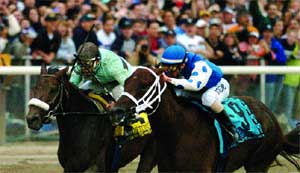They had come in droves, that crowd 120,000 strong, and they were convinced that this time it would happen. After all, last June’s 136th running of the Belmont Stakes - the mile-and-a-half coda to Thoroughbred racing’s historic Triple Crown - was to serve not as a challenge, but instead as a coronation. In recent years, there had been others at this same threshold of immortality, each of them already boasting victories in the Crown’s opening events, the Kentucky Derby and the Preakness Stakes. None, however, had been able to close the deal. None had proven durable, composed or lucky enough to prevail in this last test.
 |
| Triple Crown contender Smarty Jones (right) is passed in the stretch by Birdstone in the 2004 Belmont Stakes |
Not since Seattle Slew 27 years earlier had a Triple Crown hopeful rolled into the final leg of the series sporting an unblemished record. By the time he arrived at the
 And then Smarty Jones lost.
And then Smarty Jones lost.
“It was palpable anguish. I mean, people were crying,” recalls journalist, radio host and die-hard racing buff Jason Levin.
“You know, it was that deafening silence. It was the air being let out of 120,000 people at the same time. Like a stomach punch where you just doubled over, going, “I can’t believe that guy just hit me and I can’t breathe.’”
To just about everyone, the
That question, in varying forms, has been eating at racing enthusiasts for years. Since 1978, when rivals Affirmed and Alydar staged their dramatic battles, no horse has managed to pull down the Kentucky Derby, Preakness and Belmont. It is the longest such interval in the sport’s history. Over the past 129 years, in fact, the Triple Crown has been attained by just 11 horses, while many, many more have tried but failed to go the distance. Today, the Triple Crown remains one of the most monumental accomplishments in all of sports.
“There’s nothing like it. It’s just physically draining,” explains William Nack, retired senior writer for Sports Illustrated and author of Secretariat: The Making of a Champion.
 “I would happen to think that in a real competitive era - back in the old days - the hardest thing to do in sports was to win the heavyweight championship of the world, especially when Joe Louis was on top, or Rocky Marciano, or Muhammad Ali. But not anymore. There’s nothing that can possibly compare to this.”
“I would happen to think that in a real competitive era - back in the old days - the hardest thing to do in sports was to win the heavyweight championship of the world, especially when Joe Louis was on top, or Rocky Marciano, or Muhammad Ali. But not anymore. There’s nothing that can possibly compare to this.”
During a five-week span every May and June, the Triple Crown presents owners and trainers the chance to prove their three-year-old Thoroughbreds in a classic series of prestigious and demanding races - the Kentucky Derby, the most coveted of all prizes in horse racing; the Preakness Stakes, run two weeks later at Pimlico Race Course in Baltimore; and the Belmont Stakes, known as the “Test of the Champion,” which is held at Belmont Park on Long Island three weeks after the Preakness. Prestige and purse money aside, Visa has sweetened the deal in the last decade, promising a $5-million bonus to the owner of the horse that sweeps all three.
Although its three-year-old competitors are still in the stages of physical and mental development, the Triple Crown demands that they endure the stress of traveling around the country, competing on different track surfaces at race distances they’ve never before seen, and performing before throngs that usually exceed 100,000 people.
“It’s a grind. There’s been a lot of real good horses ruined trying to do this, trying to get ready to do it. I guess we’ve been fortunate to have 11 of them,” says Racing Hall of Fame member Buddy Delp, who trained
“The horses that try to get through those three races, it really knocks them,” adds Will Farish, owner of Lane’s End Farm in
That the Triple Crown is a punishing task is undeniable. Only the strongest have withstood all the pressure. For every Citation there have been many like Point Given, who flopped in the
But what’s with the long dry spell? From 1973 through 1978 alone, there were three standouts - Secretariat, Seattle Slew and Affirmed - who overcame every obstacle and opponent thrown their way. Since then, those on the brink of a Triple Crown have gone 0-for-10 in the
Can breeding attitudes and economics provide us an answer? Has the sport just hit a patch of bad luck? The theories abound.
One thing is a certainty, though: There are vastly more horses to compete against today than decades ago. During the 1940s, an era that produced four Triple Crown winners, the average yearly foal crop (the number of Thoroughbred foals born in
These numbers have led to fewer dominant horses, spreading the talent instead over a wider range and thus creating a greater balance of competition. As foal crops have escalated, so too has participation in the spring classics, especially in the Preakness and Belmont. This naturally has complicated matters in the Triple Crown. Affirmed, for example, dealt with a total of 20 opponents in his Triple Crown victories of ‘78, including a mere four in the
“There’s a corollary to that, though,” says Levin, author of From the Desert to the
Of course, the Kentucky Derby has always been principal target of the Triple Crown events, appealing to every red-blooded owner and trainer with a decent three-year-old on their hands. It consistently attracts the largest fields, quite often pushing its quota of 20 horses. To earn a cherished spot in the
D. Wayne Lukas, whose stable has been home to 23 national champions over the last quarter-century, entered his first runner in the Kentucky Derby in 1981. Since then, he has had more entrants in the
“When I originally started doing it, I was thinking, “I don’t want to go to the well. I want to leave a little in the tank at the
Even so, those who do survive the rigors of the
“They had an easier road and they came into the
To fully condition young Thoroughbreds for every possible twist and turn of the Triple Crown - for the traffic-plagued Derby, for the tight turns at Pimlico, for the Belmont ambushers - it would seem reasonable for horsemen to s/files/storyimages/them into the trenches early and often, thereby toughening them up while providing them invaluable lessons. In a different era, this was certainly the case. During the ‘70s, for instance, every Derby winner - with the exception of Seattle Slew - had arrived in Louisville having run at least 11 races beforehand. This was not a novel idea. The Triple Crown champs of the 1940s - Whirlaway, Count Fleet, Assault and Citation - likewise had been pushed hard early on, as had many, many subsequent
But times have changed considerably. In the last 20 years, horses have come to Churchill Downs with significantly less racing experience. Only three
Ron Ellis trains the 2004 Eclipse Award champion male juvenile Declan’s Moon, a
“I don’t think that these horses are running any easier even though they’re running less races. They’re just having to run much harder and faster because the competition is deeper,” he explains. “I think you can equate horses to baseball pitchers really. You know, you get 12-year-olds that are pitching in the Little League World Series and throwing a bunch of curveballs, and they’re not the guys that are pitching in the major leagues later on. It’s because it’s too much too young. They’re throwing hard when they’re young and then their arm just doesn’t have any strength. To me, it’s the same thing: If these horses do too much too early, if it doesn’t hurt their minds, it somehow hurts their overall strength. They’re just worn out.”
“If you tried to subject an American racehorse of the 21st or the late 20th century to the same kind of regimen that Citation, Secretariat or Affirmed was subjected to, he wouldn’t stand it for a week,” Nack argues. “The general quality of the American Thoroughbred has declined in the last 25 years.
I don’t think there’s any question about it.”
A dynamic shift toward commercial breeding, he says, is the culprit. In the post-Depression era, there was a dramatic increase in the importation of stallions from abroad, and the long-term influence of this foreign blood on domestic pedigrees eventually led to the prolific ‘70s, an interval that produced not only three Triple Crown legends - Secretariat, Seattle Slew and Affirmed - but such renowned competitors as Riva Ridge, Forego, Ruffian, Alydar and Spectacular Bid.
“We’ve never had a decade like it,” says Nack. “Those are some of the greatest horses who ever raced.”
Attitudes abruptly changed beginning in the early ‘80s, however, when bloodstock became wildly valuable, breeding for the market heightened, and countless blue-blooded mares and their offspring were dispersed, primarily to overseas investors. The result was an inferior gene pool.
“That to me is the crux of the problem: Everything was for sale,” says Nack. “Another thing that’s compounded it is that the great sires - the speed sires - are unsound. People breed to them anyway because they had tremendous speed, and as you know, speed is the bottom line in American racing. It’s coveted more than anything. Those weaker pedigrees have produced horses that haven’t been able to stand up to training. You can’t overdo it with them early or they won’t make it. The durability is not what it was, but I don’t think the quality is either. The way the American breed is today, I don’t think it’s capable of producing a Secretariat or even a Spectacular Bid.”
Seth Hancock, president of Claiborne Farm in
“They’re all under the same cloud,” says Hancock. “It’s a correct statement to say that today’s horse is not as durable as the one of 25 years ago, and for sure not of the one 50 years ago. I mean, it’s just a fact that horses don’t run as much today as they used to.”
Despite the discrepancy between the current breed and horses of yesteryear, one fact still gives horsemen and hardboots alike cause for optimism: In the past eight years alone, six horses have managed to pocket the
Following Citation’s sweep in 1948, racing spent a quarter-century in the same rut. Then Secretariat came along and the world was right once more.
And how bad can it really be? After all, it took the Boston Red Sox 86 years to get off their schneid.
“When I first started running the farm back in 1972, they all said the same thing then - “Well, it’s just too hard, can’t be done again, won’t be done again,’” Hancock says. “And then we had three of them in a six-year span. I think that’s the same way it is now. It’s going to happen soon. It’s just a matter of when.”
“I think there’ll be one, yeah. I definitely think there will,” echoes Delp. “There’ve been 11. Why shouldn’t there be another one sometime?”
That’s a question only a racehorse can answer.


